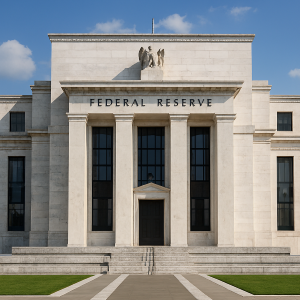The U.S. Federal Reserve System: America’s Central Bank
Federal Reserve (FED) is America’s central bank, managing monetary policy, supervising banks, and ensuring economic stability. Learn how the Fed impacts the U.S. economy. Explore the history of the U.S. FED, from its founding in 1913 to key milestones in monetary policy and economic stabilization. Learn how the Fed shaped the American economy.
📌 What Is the FED?
FED is the central banking system of the United States. It plays a vital role in maintaining economic stability, regulating banks, and influencing monetary policy to support growth and employment.
Established in 1913, FED serves as the central bank of the United States. Its mission is to promote a stable financial system, control inflation, and foster economic growth.
✅ FED manages the U.S. money supply, supervises banks, and implements monetary policies to maintain economic stability.
📌 Structure of the FED
FED has a unique structure, combining public and private elements:
- Board of Governors: Seven members, appointed by the President, overseeing the Fed’s operations.
- 12 Regional Reserve Banks: Located across the U.S., each serving its local economy.
- Federal Open Market Committee (FOMC): Sets monetary policy, including interest rates and money supply decisions.
👉 This structure allows the Fed to balance national monetary policy with regional economic needs.
📌 Key Functions of the FED
- Monetary Policy: Adjusts interest rates, controls money supply, and manages inflation.
- Bank Supervision: Regulates and supervises commercial banks to ensure stability.
- Financial Services: Provides services to banks, the U.S. government, and financial institutions.
- Economic Stability: Acts as a lender of last resort during financial crises.
📊 For example, during the 2008 financial crisis and the 2020 COVID-19 pandemic, the Fed implemented emergency measures to stabilize markets.
📌 Importance of the FED
- Influences the Economy: Decisions on interest rates impact borrowing, spending, and investment.
- Global Impact: U.S. monetary policy affects international financial markets.
- Investor Confidence: Fed actions guide expectations in stocks, bonds, and currencies.
✅ FED regulates the U.S. money supply, supervises banks, and implements policies to ensure economic stability.
The History of the U.S. FED: Key Milestones
The U.S. FED has guided America’s financial system for over a century. Its history reflects the evolution of U.S. monetary policy, banking regulation, and economic stability.
📌 Origins of the FED (1913)
- Founded in 1913 with the FED Act, signed by President Woodrow Wilson.
- Created in response to recurring financial panics, particularly the 1907 banking crisis.
- Established as a central bank to provide stability, regulate currency, and oversee banks.
✅ FED was founded in 1913 to stabilize the U.S. financial system and regulate banks.
📌 Early Milestones (1914–1930s)
- 1914: FED Banks begin operations in 12 districts across the U.S.
- 1920s: Fed implements early monetary policies to manage inflation and credit.
- 1930s: During the Great Depression, the Fed expands its role in economic stabilization and banking oversight.
📌 Mid-20th Century Developments
- 1942–1951: Fed supports World War II financing while maintaining inflation control.
- 1950s–1970s: Introduction of modern tools like open market operations and discount rate adjustments.
- 1970s: Tackles high inflation with tighter monetary policy, establishing its role as an economic stabilizer.
📊 These developments solidified the Fed’s authority in managing U.S. monetary policy.
📌 Modern Era (1980s–Present)
- 1980s: Paul Volcker’s Fed combats runaway inflation, restoring confidence in U.S. currency.
- 2008: During the financial crisis, the Fed implements emergency measures, including low interest rates and quantitative easing.
- 2020: In response to the COVID-19 pandemic, the Fed injects liquidity and supports financial markets to stabilize the economy.
- 2023–2025: Continues to balance inflation control, employment growth, and economic recovery.
✅ FED has guided the U.S. economy through crises, inflation, and growth since 1913, using tools like interest rates and quantitative easing.
📌 Why the Fed’s History Matters
- Economic Stability: Provides tools to manage recessions, inflation, and financial crises.
- Global Influence: Fed policies affect international markets, currencies, and trade.
- Investor Confidence: Decisions on interest rates and monetary policy guide investments across stocks, bonds, and commodities.
🔎 Quick Answers
What is the FED?
The U.S. FED is the central bank of the United States. It manages monetary policy, supervises banks, and promotes financial stability and economic growth.
When was the FED founded?
The U.S. FED was founded in 1913 to stabilize the financial system and regulate banks.
✅ Conclusion
Federal Reserve System is more than a central bank, it is the backbone of the American financial system. By guiding monetary policy, supervising banks, and responding to crises, the Fed ensures stability, growth, and confidence in the U.S. economy. FED has evolved over more than a century to become the backbone of American financial stability. From its founding in 1913 to modern innovations in monetary policy, the FED continues to shape the economy and protect the nation’s financial system. For more detailed information about FED, you can visit its official web site. Please also feel free to contact us on any business issue and our services. With over 25 years of expertise, knowledge, and experience in Business Law, we are here to help you. Additionally, you can explore the books of our Founder, Dr. Soner Altaş, in the field of Commercial Law, or take a closer look at Tacirsoft Legal Information System — Turkey’s first and only legal database dedicated to Turkish Corporate Law and Organized Industrial Zones Law.


